As spring dawns, a national nature advocacy group hopes to see shifts in lawn care to include earlier options for pollinators and other key environmental critters.
No Mow May is an annual campaign by Plantlife, a conservation group in England, and entails exactly what it sounds like – resisting the urge to cut the lawn this month leaving weeds to feed pollinators. While some may attempt the trend, the Nature Conservancy of Canada (NCC) urges people to skip to the next step – naturalizing yards.
With about 6.2 million lawns across the nation, it is exciting to see people who want to help nature, said Andrew Holland, NCC national media relations director.
READ ALSO:
“We are suggesting they use native plants – trees and flowers – in their yards to have a lasting impact,” he said, adding many plants bloom before dandelions and are more nutritious.
Most people are interested in helping bees, but the organization hopes to see residents go beyond for all pollinators, including hummingbirds, bees, butterflies, moths, beetles and ants.
“For some people that still want to mow their lawn, we urge people to convert a small portion of the property, whether it is their lawn, flower or garden beds to native plants to have an impact,” Holland said. Those living in apartments and condo buildings could add a native plant or two to the deck or balcony.
READ ALSO:
With about 80 per cent of Canadians living in urban settings, choosing wisely can benefit local neighbourhoods, said Samantha Knight, NCC’s national conservation science manager. Native plants are an integral part of the ecosystem and can help wildlife populations, improve the health of urban ecosystems and foster connection with nature.
“The plants we choose to grow will have a significant influence on the diversity and abundance of native wildlife. Native trees, shrubs and wildflowers support a greater diversity of pollinators and other insects than traditional horticultural plants and are an opportunity to learn about local biodiversity,” Knight said.
Native plants evolved alongside wild insects and as a result, provide better habitat than ornamentals. Invasive species can also crowd native ones and hinder growth.
For inspiration and ideas visit . To find a local native plant society visit .
Do you have a story tip? Email: c.vanreeuwyk@blackpress.ca.
Follow us on and and like us on



